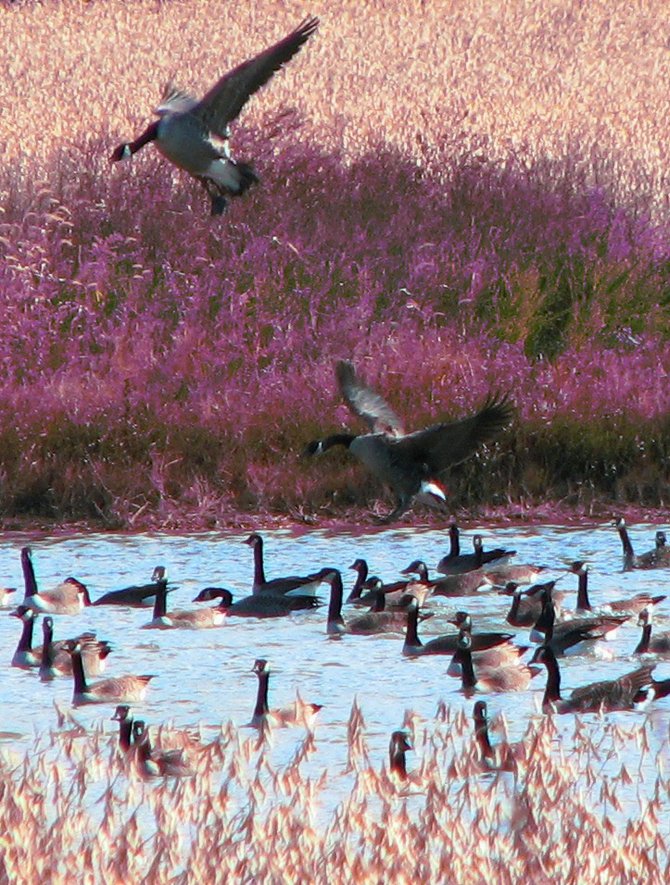 Facebook
Facebook
 X
X
 Instagram
Instagram
 TikTok
TikTok
 Youtube
Youtube

As I drove east across the Chesapeake Bay Bridge at dusk, a Peregrine falcon rose from the water over the railing and above the car into the trusses above, a fish gripped firmly in its claws.
There’s a whole lot more living on the Bay – the largest estuary in the United States – than the infamous retrievers. Once renowned for its oysters (if not for the turn-of-the-century Oyster Wars), the Chesapeake Bay is best known today for its crabs. It’s also regrettably home to one of the country’s four dead zones, hypotic (oxygen-depleted) waters unable to sustain life. Although in decline, the bay still harvests the majority of crabs sold in the country.
The dead zone located along the Atlantic Flyway doesn’t seem to deter millions of migrating birds from touching down or wintering in the subtropical, if not humid, marshlands either. Not yet, at any rate. The abundance of wintering Canadian and snow geese and resident tundra and mute swans contribute to the bay’s acclaim for being one of the best waterfowl hunting grounds in the world. Camouflaged sportsmen from around the world flock to the shores throughout the wildfowl season, contributing heftily to the state’s maritime tourism industry.
Voted the 8th best small town in America, Easton is a colonial town of less than 15,000 about two hours east of Washington, D.C. It sponsors the internationally acclaimed annual Waterfowl Festival every November.
Ten dollars will admit you to the weekend-long art and sportsman expo; however, an additional fee is required to view the World Champion Goose and Duck Callers Contest. Festivities include Chesapeake Bay Retriever dog shows as well as fly fishing demonstrations, an antique decoy auction, master sportsmen classes, wine tasting, live music and blocks of vendors and artisans.
When you go, set aside an hour or two to stroll through the quaint walkable colonial village with beautifully preserved historic homes. A few blocks back, grand Victorians provide evidence of the post-Civil War railroad boom.
While in town, eat dinner at one of the many excellent restaurants. Out of the Fire Restaurant and Wine Bar on Goldsborough Street not only operates on a socially responsive sustainability policy (organic produce, environmentally conscious seafood choices as advised by the Monterey Bay Seafood Watch, free-range antibiotic and growth-hormone free meats and an array of vegetarian and vegan menu selections), it also grills up one of the best trout dishes I’ve ever tasted.
Peek into the storefronts and meet the friendly locals – not all of whom are native to the watermen’s state. Easton’s Green Energy and Design, for instance, was founded by longtime SoCal residents. Before returning home, treat yourself to Far Eastern Shore Winery and the seriously delicious Autumn Swan Blanc flavored with white cranberry juice.


As I drove east across the Chesapeake Bay Bridge at dusk, a Peregrine falcon rose from the water over the railing and above the car into the trusses above, a fish gripped firmly in its claws.
There’s a whole lot more living on the Bay – the largest estuary in the United States – than the infamous retrievers. Once renowned for its oysters (if not for the turn-of-the-century Oyster Wars), the Chesapeake Bay is best known today for its crabs. It’s also regrettably home to one of the country’s four dead zones, hypotic (oxygen-depleted) waters unable to sustain life. Although in decline, the bay still harvests the majority of crabs sold in the country.
The dead zone located along the Atlantic Flyway doesn’t seem to deter millions of migrating birds from touching down or wintering in the subtropical, if not humid, marshlands either. Not yet, at any rate. The abundance of wintering Canadian and snow geese and resident tundra and mute swans contribute to the bay’s acclaim for being one of the best waterfowl hunting grounds in the world. Camouflaged sportsmen from around the world flock to the shores throughout the wildfowl season, contributing heftily to the state’s maritime tourism industry.
Voted the 8th best small town in America, Easton is a colonial town of less than 15,000 about two hours east of Washington, D.C. It sponsors the internationally acclaimed annual Waterfowl Festival every November.
Ten dollars will admit you to the weekend-long art and sportsman expo; however, an additional fee is required to view the World Champion Goose and Duck Callers Contest. Festivities include Chesapeake Bay Retriever dog shows as well as fly fishing demonstrations, an antique decoy auction, master sportsmen classes, wine tasting, live music and blocks of vendors and artisans.
When you go, set aside an hour or two to stroll through the quaint walkable colonial village with beautifully preserved historic homes. A few blocks back, grand Victorians provide evidence of the post-Civil War railroad boom.
While in town, eat dinner at one of the many excellent restaurants. Out of the Fire Restaurant and Wine Bar on Goldsborough Street not only operates on a socially responsive sustainability policy (organic produce, environmentally conscious seafood choices as advised by the Monterey Bay Seafood Watch, free-range antibiotic and growth-hormone free meats and an array of vegetarian and vegan menu selections), it also grills up one of the best trout dishes I’ve ever tasted.
Peek into the storefronts and meet the friendly locals – not all of whom are native to the watermen’s state. Easton’s Green Energy and Design, for instance, was founded by longtime SoCal residents. Before returning home, treat yourself to Far Eastern Shore Winery and the seriously delicious Autumn Swan Blanc flavored with white cranberry juice.
Comments